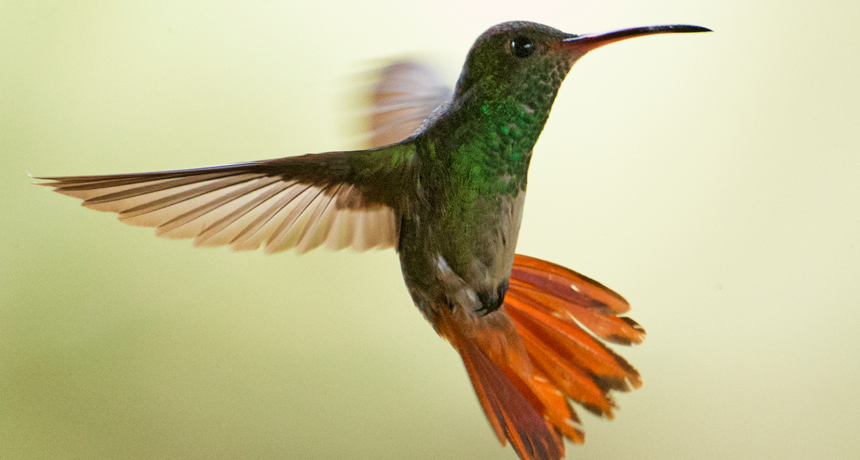
WHAT TO WATCH The fast turns of hummingbirds have inspired a massive motion-tracking study of the birds’ flight maneuvers.
Lip Kee/Flickr (CC BY-SA 2.0)
Lab-grade flight tracking has gone wild, creating a broad new way of studying some of the flashiest of natural acrobats, wild hummingbirds.
One of the findings: Bigger hummingbird species don’t seem handicapped by their size when it comes to agility. A battleship may not be as maneuverable as a kayak, but in a study of 25 species, larger hummingbirds outdid smaller species at revving or braking while turning. Measurements revealed these species have more muscle capacity and their wings tended to be proportionately larger for their body size than smaller species. Those boosts could help explain how these species could be so agile despite their size, researchers report in the Feb. 9 Science.
Adapting a high-speed camera array and real-time tracking software to perform in field conditions let the researchers analyze more than 200 wild birds swerving and pivoting naturally. With over 330,000 bird maneuvers recorded, the researchers could compare the agility of the different species. It’s the first comparative study of natural flight moves in wild birds, says coauthor Roslyn Dakin, who is based in Ottawa with the Smithsonian Conservation Biology Institute.
“What makes this research a clear advance is the methods they used,” says Christopher J. Clark of the University of California, Riverside. His hummingbird studies have revealed how the birds’ feathers squeal during flight (SN: 4/4/15, p. 5), but he was not involved in the new research.
In the experimental setup, four cameras film a temporary flight chamber in the field. Customized computer software allows the team to track birds in 3-D as they explore the space in any way they choose.
The project began almost a decade ago when coauthor Paolo Segre adapted and then hauled the flight-tracking system to Ecuador, Costa Rica and Peru — great places to find hummingbirds with different wing shapes and body sizes, but hard on equipment. At the time, he needed five computers, sometimes running just on solar panels and a generator in the Amazon. “We were in a thatched hut,” accessible only by several hours’ boat ride, he says. “Monkeys poked their heads in.” Since then, computers have improved, and one machine is enough to run the software.
The new paper uses some of this hard-won data to focus on two kinds of turning maneuvers — a simple flying arc and a pitch-and-roll move that Dakin calls “turning on a dime.” That involves the bird slanting its body and then pivoting in place.
Birds’ agility did not appear to be affected in field sites at higher elevations. In theory, less oxygen and lower air pressure should make athletic flying tougher. An earlier study by the same researchers found that Anna’s hummingbirds (Calypte anna) accelerated more slowly and had other performance falloffs at altitudes higher than the birds’ home range. Yet birds that call those higher elevations home had adapted to the conditions.
Studying how hummingbirds, or even birds in general, maneuver has been hard to do. Previous approaches to understanding bird motion were limited to capturing data on animals performing set tasks. “A ballerina has a number of different moves,” Clark says, but “so far we’ve just studied individual moves.” Now researchers are starting “to put together the entire dance.”
TRACK THAT FLIGHT The deft turns of hummingbirds in flight, as shown in a competitive encounter (first clip), make great material for studying agility. In a new study, a customized tracking system (second clip) set up in Costa Rica notes the position (blue) and orientation (red) of a wild Eugenes fulgens as it explores a temporary flight cage. |





